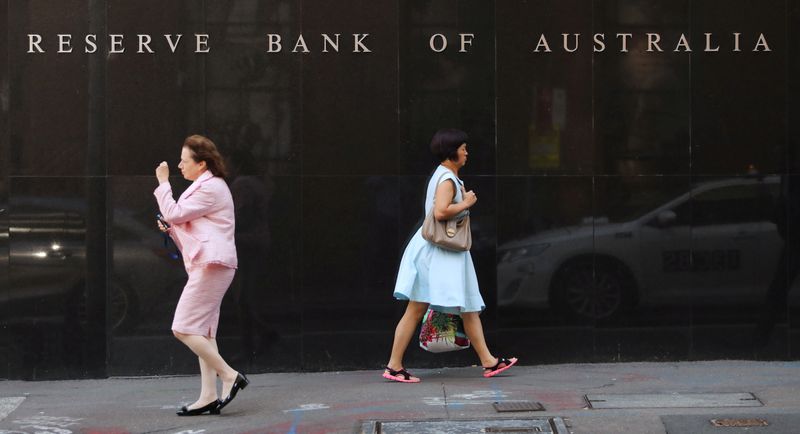By Stella Qiu
SYDNEY (Reuters) -Australia's central bank held interest rates steady on Tuesday as expected, buying it more time to assess the state of the economy and decide whether to tighten further next year even as the U.S. and Europe are seen as almost certain to ease.
Wrapping up its December policy meeting, the Reserve Bank of Australia (RBA) kept rates at a 12-year high of 4.35%, adding economic data received since November - when it hiked by a quarter-point - had been broadly in line with expectations.
Markets had wagered heavily on a steady outcome given inflation had eased a little more than expected in October. They slightly pared back the chance of a further rise to 4.6% in the new year to 38% from 43% before the no-change decision.
The local dollar extended earlier declines to be down 0.6% to $0.6581 and three-year Australian government bond yields eased 5 basis points to 4.00%.
"Holding the cash rate steady at this meeting will allow time to assess the impact of the increases in interest rates on demand, inflation and the labour market," RBA Governor Michele Bullock said.
Bullock also stuck with the watered down tightening bias from last month, saying whether further rate hikes are required would depend upon the data and the evolving assessment of risks.
It was the RBA's last chance to raise rates before its next meeting in February and provided Christmas relief to mortgage holders, many of whose monthly payments have jumped by more than A$1,000 ($662) a month amid elevated costs of living.
"The statement, in our view, was less hawkish than November's and also less hawkish than we expected," Barclays analysts said in a note to clients.
"We continue to think the hiking cycle is over, though we do note the bank's data dependent approach means the possibility of another hike after the Q4 inflation print." Those figures are due in late January, ahead of the next RBA meeting on Feb. 6.
Bullock has sounded hawkish in recent public comments, warning that inflation has become increasingly driven by domestic demand, requiring a more "substantial" response from interest rates.
At present, inflation is not forecast to return to the bank's 2% to 3% target until late 2025.
LIMITED INFORMATION
The RBA saw the monthly inflation report for October, which fell by more than expected, as insufficient to provide an update on services. It expects wages, which rose at a record pace last quarter, to ease from here, and the labour market remains tight despite signs of easing.
Rates have now risen by 425 basis points since May last year in the most aggressive cycle on record, but the size of hikes has lagged its overseas counterparts because of the central bank's attempt to preserve jobs gains.
"I think their hope would be that the November hike has stamped out some of those inflation concerns at least in the short term. And really the global story too probably works in their favour," said Madeline Dunk, an economist at ANZ.
Markets are expecting early and aggressive rate cuts from the U.S. Federal Reserve and the European Central Bank in 2024, with more than 100 basis points priced in, while wagering the RBA could just cut by 15 basis points late next year.

"If we see a continuing momentum over there (Fed rate cuts), it does support the case that they can be done at 4.35%. But I think they would want to keep the option open just in case," Dunk said of the RBA.
(A$1 = $0.6617)